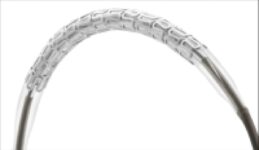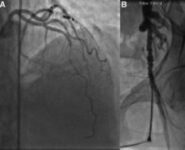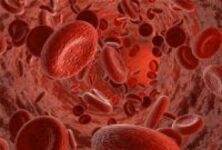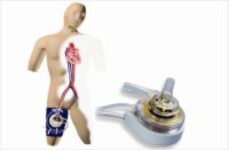Original title: Incidence and predictors of stent trombosis: a single-centre study of 5833 consecutive patients undergoing coronary artery stenting Reference: Javaid Iqbal et al. EuroInterventional 2013;9:62-69 Though potentially fatal, stent thrombosis is a low frequency event associated to stent malapposition, fractures, resistance to antiplatelet therapies, and diseases such as diabetes and kidney disease, among other factors. 5883 pacients…
Improved efficacy and also increased bleeding with Rivaroxaban in Acute Myocardial Infarction
Original title: Rivaroxaban in Patients Stabilized After a ST-Segment Elevation Myocardial Infarction. Results From the ATLAS ACS-2–TIMI-51 Trial. Anti-Xa Therapy to Lower Cardiovascular Events in Addition to Standard Therapy in Subjects with Acute Coronary Syndrome Thrombolysis In Myocardial Infarction-51. Reference: Jessica L. Mega et al. J Am Coll Cardiol 2013;61:1853–9. Morbidity and mortality rates following AMI have progressively…
First results of bioabsorbable metal scaffolds DREAMS
Original title: Safety and performance of the drug-eluting absorbable metal scaffold (DREAMS) in patients with de-novo coronary lesions: 12 month results of the prospective, multicentre, first-in-man BIOSOLVE-I trial. Reference: Michael Haude et al. Lancet 2013; 381: 836–44. Bioabsorbable scaffolds could improve vasomotion, remodelling and facilitate new interventions, both percutaneous and surgical. This new bioabsorbable scaffold, different from the…
Women have a higher mortality rate in ST-segment elevation acute myocardial infarction
Original title: Is the difference in outcome between men and women treated by primary percutaneous coronary intervention age dependent?: Gender difference in STMI stratified on age Reference: Amber M Otten et, al.European Heart Journal Acute Cardiovascular Care January 31:1-8 Numerous publications have shown that women have worse outcomes than men in chronic ischemic heart disease but their evolution…
Spontaneous coronary artery dissection (SCAD) is associated with fibro-muscular dysplasia in other territories
Original title: Spontaneous Coronary Artery Dissection. Prevalence of Predisposing Conditions Including Fibromuscular Dysplasia in a Tertiary Center Cohort Reference: Jacqueline Saw, et al. J Am Coll Cardiol Intv 2013;6:44 –52 Non atherosclerotic spontaneous coronary artery dissection (Non atherosclerotic SCAD) is a rare disease that is associated with acute myocardial infarction and sudden death. This condition is more common…
Intracoronary enalaprilat reduces periprocedural injury.
Original title: Intracoronary Enalaprilat to Reduce Microvascular Damage During Percutaneous Coronary Intervention (ProMicro) Study. Reference: Fabio Mangiacapra et al. J Am Coll Cardiol 2013. Article in press Angiotensin converting enzyme (ACE) inhibitors improve clinical outcomes in patients with coronary artery disease and improve epicardial flow in patients with acute ST-segment elevation. Beyond the long-term protective effect of oral…
Thrombus Aspiration is useful in AMI
Original title: A Prospective Randomized Trial of Trombectomy Versus No Thrombectomy in Patients With ST-Segment Elevation Myocardial Infarction and Thrombus-Rich Lesion. MUSTELA (MUltidevice Thrombectomy in Acute ST-Segment ELevation Acute Myocardial Infarction) Trial Reference: Marco De Carlo, et al. J Am Coll Cardiol Intv 2012;5:1223–30 The main objective during primary PCI is myocardial reperfusion, which is limited by distal…
Serum fibrinogen is a better predictor of periprocedural events than platelet reactivity.
Original title: Elevated Plasma Fibrinogen Rather Than Residual Platelet Reactivity After Clopidogrel Pre-Treatment Is Associated With an Increased Ischemic Risk During Elective Percutaneous Coronary Intervention. Reference: Lawrence Ang et al. J Am Coll Cardiol 2013;61:23–34. Platelet function tests have identified differences in the response of each patient to clopidogrel and minor platelet inhibition has been associated with thrombotic…
Ticagrelor, even better than we thought
Original title: Reduction in First and Recurrent Cardiovascular Events with Ticagrelor Compared with Clopidogrel in the PLATO Study. Reference: Payal Kohli et al. CIRCULATION AHA.112.124248. In analyzing randomized and monitored study outcomes, we usually observe that after the occurrence of any primary outcome event patients are typically blocked for further analysis. This practice limits the information on subsequent…
Self-expanding stents improve positioning in primary angioplasty
Original title: Self-Expanding Versus Balloon-Expandable Stents in Acute Myocardial Infarction: Results From the APPOSITION II Study Reference: Robert-Jan van Geuns et al. J Am Coll Cardiol Intv 2012;5:1209–19 Acute myocardial infarction is associated with vasoconstriction and thrombus occlusion. Resolution of these two points during the first hours after primary angioplasty can lead to poor extension and poor positioning…
More evidence supports ventricular assist devices in complex angioplasty procedures
Original title: Percutaneous Left Ventricular Assist Device with Tandem Heart for High-Risk Percutaneous Coronary Intervention: The Mayo Clinic Experience. Reference: Oluseun O Alli, et al. Catheterization and Cardiovascular Intervention 80:728:734 There is a small group of poor surgical patients admitted for surgery that due to complex comorbidity, coronary anatomy and compromised left ventricular function that can be treated…










